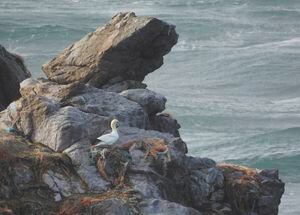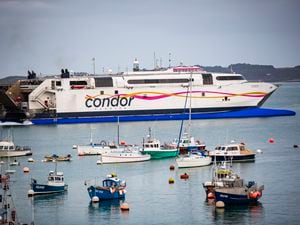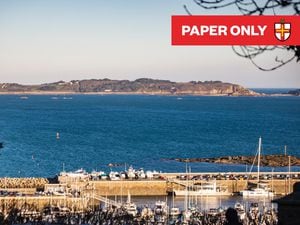Alderney records first gannet of the year
GANNETS are on the cusp of landing in Alderney.

Last Saturday, the Alderney Wildlife Trust recorded the first gannet to touch down this year.
Since then the gannet has left the rock to join hundreds of others gathered nearby.
Alderney Wildlife Trust avian ecologist Justin Hart said: ‘We’re surprised that no others have followed suit and expect landfall any day. Most are on the sea but some are circling both Les Etacs and Ortac.
Last year the birds made landfall soon after their return, he said, but this year they are being more hesitant. ‘We’re not sure why. I guess just as one swallow does not make a summer, neither does one gannet make a colony landfall.’
Northern gannets nest for the breeding season between February and October.
‘The arrival signifies the first glimmer of spring,’ Mr Hart said. ‘Spring arrives early in the sea. To return, there must be enough food in the Channel. It’ll be late March before they first lay an egg.’
It is uncertain how many breeding pairs will arrive this year.
‘The last colony census was in 2015 with the following results: Les Etacs 5,960, Ortac 2,777,’ Mr Hart said. ‘These are occupied sites so represent pairs.’
A colony census is carried out every five years.
‘This year we are planning to count the colonies again, sometime in May or June when most birds will be incubating eggs.’
Alderney’s gannet colonies were founded during the Second World War.
‘A pioneering pair was seen incubating an egg on Ortac in June 1940,’ said Mr Hart.
‘After the war, a returning fisherman noted the whole east side of Ortac had been colonised, with others on Les Etacs too.’
In 1946, 250 pairs were counted on Ortac and 200 on Les Etacs.
‘Numbers continued to rise in line with all the other gannetries around Britain,’ Mr Hart said. ‘By 2015, the pace definitely slowed as both colonies reached near maximum capacity.’
Habitats can become more treacherous with growth as more birds nest lower on the rock. ‘More summer storms are battering the colony each year, perhaps because of climate change. Nests close to the sea are more likely to be swept away,’ he said.
‘Ortac is especially vulnerable as heavy swell can break right over the top. We’re not sure of the impact yet but hope to find out.’
Over-fishing presents a risk to the colonies.
‘Both colonies are heavily reliant on the Channel for fishing. Breeding success depends on the availability of their preferred prey – mackerel,’ Mr Hart said,
‘It’s important the waters are not over-fished and sea developments do not prevent the birds from finding adequate food.’
Plastic pollution is a significant issue. Nests are built ‘primarily with seaweed collected from the sea’s surface’.
‘They’ll also collect flotsam, including discard fishing line and rope. Synthetic line is particularly harmful,’ said Mr Hart, ‘when incorporated into nests it becomes a persistent entanglement hazard.’
Plastic now covers the entire habitat, with 26 entangled gannets seen last year.
‘The suffering entangled birds endure is unacceptable in our view and particularly unpleasant to observe.’
AWT will be monitoring breeding productivity and posting regular updates on social media as the season unfolds.
‘As of this [Thursday] morning, the gannets have still not made proper landfall, although the number of birds is continuing to build.’
For updates visit: https://www.alderneywildlife.org/ and click on the relevant social media icon.





